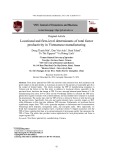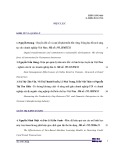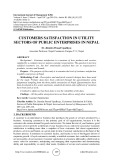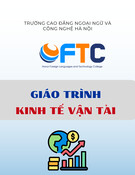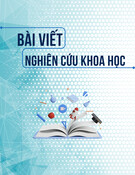
* Corresponding author
E-mail address: erna.maulina@unpad.ac.id (E. Maulina)
© 2020 by the authors; licensee Growing Science.
doi: 10.5267/j.uscm.2019.8.001
Uncertain Supply Chain Management 8 (2020) 117–130
Contents lists available at GrowingScience
Uncertain Supply Chain Management
homepage:
www.GrowingScience.com/uscm
Determinants of supply chain operational performance
Erna Maulinaa* and Kameswara Natakusumaha
aBusiness Administration Department, Universitas Padjadjaran Bandung, Indonesia
C H R O N I C L E A B S T R A C T
Article history:
Received July 12, 2019
Received in revised format July
24, 2019
Accepted August 2 2019
Available online
August
3
2019
The significant of supply chain management (SCM) on the performance of organization's is
described and evaluated in this study. The role of operational performance is examined
regarding supply chain in textile and apparel sector which is crucial for the performance of
whole organization. Textile industry of Indonesia in terms of revenue is anticipated to grow at
an aggregated gross rate of 6.01%, during forecasted period, 2015-2025. Excellent SCM is
necessary for managing this growth. Supply chain role is very crucial in this industry for
flourishing but unfortunately operational performance of supply chain is not performing on
required level. This is a cross sectional type of research and data collection from textile and
apparel firm managers which directly supervise to supply chain division. Currently business
environment is very competitive and organizations need to focus on SCOP except
organizational performance. In this study, we try to find the solution of this problem after
analyzing through jointly the mediating role of Information Technology (IT) and independence
effect of Relational Capability (RC) and Organizational Culture Capability (OCC) on supply
chain operational performance in Indonesian apparel and textile industry. Results indicate that
this research is helpful to resolve supply chain operational issues in Indonesia.
.
licensee Growing Science, Canada
by the authors;
20
20
©
Keywords:
Supply Chain Operational
Performance
Indonesia
Relational Capability
IT Capability
Organizational Cultural
Capability
1. Introduction
The concept of Supply chain management (SCM) is the group of activities of supply chain to enhance
customer value and to achieve competitive advantage on sustainable basis (Cooper et al., 2006; Huan
et al., 2004). It represents all those efforts and measures which considered by organization for
development of a smooth supply chain process. Supply chain covers all the activities involved for the
development of products, disbursement on a final destination, production process, transportation and
to coordinate the process through the best information systems required (Zsidisin & Ritchie, 2009).
Currently, the SCM studies are taking more intention of the organizations. This is because most
organizations have to access to international market through an effective SCM system (Thomas &
Griffin, 1996). SCM is based on a set of activities to involve all the stakeholders to maintain the
competitive environment (Beske, 2012; Asad & Siddiqui 2019). In recent scenario competition is
among in SCM activities (Deshpande, 2012). Many studies indicate that organizations need to be more

118
focus on SCM performance because it plays an important role in firm performance
(CONSTANGIOARA, 2012). SCM concept has been recognized to be vital importance for textiles and
apparel industry (Lam & Postle, 2006; Suryanto & Komalasari, 2019). However, based on the
Maslow’s hierarchy of needs, apparel and textile very important elements of physical needs for human
survival. Hence, this means that apparel and textiles are the necessary requirements and provide
necessary protection for people. Moreover, the apparel and textile sector has exclusive position as a
self-governing industry, starts from raw material supply for the production to deliver the final product
to end user, with considering total quality management at each step (Khai et al., 2014; Balagobei 2018).
With this evidence, indirectly, the researchers were suggested to look for complete chain while studying
textile and apparel context. Thus, this sector needs to be considered for more research, as it has a solid
position in the Maslow’s hierarchy of desires and limited studies have been accomplished.
Indonesia is one of those countries considered as the largest textile producer and ranking in top eight.
Industry of garments and textile is one of the oldest in Indonesia and a big source of employment due
to labor intensive (Vickers, 2017; Banerjee & Ofei, 2018). However, Chinese industries create a big
threat and taking a dominant position in this sector. Although in whole global textile market China is
taking 33% share and Indonesia is just only 2.01% (Anderson & Strutt, 2015; Bosupeng, 2018). The
target of Indonesian government is to increase the value of textile export at USD 73 billion till 2025,
and 5% would contribute the share in globe market through export.
1.1 Supply Chain Operational Performance (SCOP)
Supply chain operational performance is well-defined as the result of systematic, strategic, and efficient
collaboration of the conventional business functions within and outside organization, consists on
processes and activities associated with transforming material inputs into finished goods (Bharati &
Chaudhury, 2006; Linic et al., 2011; Boutayeba, 2017). In the context of this research, three elements
exist: relational capability, organizational cultural capability and IT capability which are consolidated
in measuring supply chain operational performance in order to provide a complete performance
measurement throughout the study.
1.2 Textiles and apparel Industry of Indonesia
The growth of Indonesian textile is expected during 2015-2025 at AGR of 6.01%, in revenue terms.
The recent agreement on subsidies in tariff are major factors which increase the export to Middle East,
European Union and United States.
Based on the report provided by Department of Statistics Indonesia (2016), Indonesian economy
registered growth of 5.6% which Gross Domestic Product (GDP) in current term posted a value of
(USD 2,284.80 million) in 2016 and spearheaded by the service and manufacturing sectors. According
to Indonesian Textile Association (API), one of the major contributors in manufacturing industry in
Indonesia is apparel and textile. The manufacturing sector rose to 4.8% in 2011, 2016, an improvement
from 4.7% recorded in 2011, particularly textile and apparel products, which accounted for 1.7% to the
growth within the manufacturing sector. In the last 40 years, technological development enabled textile
and apparel industry to implement new procedures and methods to increase the performance (Williams
et al., 2017; CHE & Sundjo 2018). Fashion is about technology management which utilized technology
as an important element to attract customer and gain mutual benefits (Lee, 2015; Edeme, 2018). The
adoption and application of the latest technology are required to develop the full potential of textiles
and apparel industry. Likewise, supply chain technology (SCT) is important in contributing to the
growth of the economy and their linkages to the manufacturing industry. From aforementioned, we can
conclude that, in the short term, textile and apparel industry has a limited impact on the economy, but,
in long run competitiveness, it has positively contributed towards the development of the country.

E. Maulina and K. Natakusumah /Uncertain Supply Chain Management 8 (2020)
119
2. Literature Review
2.1 Issues Related to Supply Chain Operational Performance
In Asia, technology is the real and major concern for the development of an effective SCM system.
There is a feeble accessibility of technology application in numerous developing Asian countries.
Bringing down the operational cost has been common in Asia. However, this is also the weakness of
Asia to develop an efficient logistics and distribution to diminish the cost. (Li, 2010; Fengyang, 2018)
Besides, joint effort is a range of opportunity in Asia. Presently, a huge number of the collaborative
efforts are informal (Li, 2010; Georgantopoulos et al., 2018). As a more formal form of collaboration
creates, particularly at the industry level, extraordinarily efficiency and cost savings can be realized
(Gholami et al., 2013).
From this discussion it is easy to understand, the efficient SCM system is only possible if the latest
technologies applied in the right firm on right time, it is the major competitive edge on one organization
to other (Motwani et al., 2000; Gyebi et al., 2013). However, it is very hard task and needs a great
investment of time and financial resources (Li et al., 2017; Nazempour, & Yang 2019), A lot of
multinational firms enrollee their unit of businesses and acquisitions throughout the global to gain a
competitive advantages in supply chain system (Akgün et al., 2013; Negrut, 2017). The huge
investment at initial level is restricted the vendors to enter in competitive situation. The multinational
firm can adopt this complex and cost intensive system because they have resources and enough budget
to finance such plans and it would not be feasible for small and medium businesses to adopt due to
resource constraint (Lee et al., 2014). As indicated, most of the business entities in Indonesian’s apparel
and textile industry are based on medium and small enterprises. According to GBP report (2014),
almost 78% of Indonesian textile and garment industry were medium and small entities. The same
situation holds for Thailand and Hong Kong textile industry faced in SCM System (Loon et al., 2016;
Nzimande & Padayachee 2017).
The expansion in medium and small entities is a vital growth engine and core strength of economy
(Lee, 2015; Okechukwu & Hyginus 2017). Specifically, Indonesia textile and apparel SMEs offered
utilization of resources, employment opportunities, foreign-currency accumulation, and ultimately
enhanced national economic development. Ab Talib et al. (2015) stated that the big organizations are
more encouraged to avail the benefits of SCM in Indonesia, but SMEs have not access to skills and
resources which enable to get the potential benefits of SCM. Textile and apparel market demand is
uncertain and unpredictable. The nature of this industry leads to high market mediation costs such as
loss sales opportunities (e.g., stock outs) during peak season or outstrips inventories during low season
and gradually obsolete inventories were generated. SCM is a key to provide cost reduction to textile
and apparel organizations through increases speed and flexibility. However, true agility requires a high
degree of visibility throughout the supply chain. The industry practitioners should recognize the power
of supply chain technology adoption in facilitating the issue in this industry (Olowa, 2018).
In current era the role of technology is very crucial which enhance the ability of organization in SCM
to get an exclusive benefit from this volatile market. Therefore, firms exploit innovative technologies
to direct access to cross border economies as an infinite business to gain economical advantage (Chan
& Qi, 2003; Ozturk & Ozturk 2018). Besides, information technology (IT) capability has been strong
moderating effect on the relationship between service innovation and supply chain performance.
Furthermore, prominent role of IT personnel for the reengineering project is crucial to avoid the efforts
being failure. For instance, IT personnel provides new technology application training for employees
at the right time to avoid shortage of trained personnel that can affect supply chain performance.
In modern business climates, firms have survived by endlessly increasing competition and economy
globalization. Generally, IT has made dramatic different in productivity and service level. In current

120
market, the use of information technology created a very strengthen network of distribution to achieve
the level of customers satisfaction which is able to find everything under the same place such as all
rotten life products (Jesus & Rocio, 2011; Ramuhulu & Chiranga 2018). The good relationship with
customer is crucial to achieve their requirements and expectations. Besides, the application of IT in
firms are common now and it has proved to cut the level of cost, improved services, enhanced supply
chain partnership, allow direct link to suppliers/ customers, reduced production cost, shorter lead time,
and minimized inventory level.
In the boundless business environment, businesses are faced an increasing customers pressure in
product customization, enhancement of quality, and response demand more than before (Agami et al.,
2012; Leng & Zailani, 2012; Rismayadi & Maemunah 2018). Previously, organizations only though
about the internal improvement in businesses and reduce the wastage and became more efficient, but
now a day’s they are not only looking internally but also giving more intention externally to become
more efficient and gaining competitive strength. Therefore, continues operational improvements
internally and externally make organization more efficient. Socio Economic and Environment Research
Institute (2007) stated that “the low labor costs were crucial for textile and apparel organization”, but
the other aspects are also important such as availability of human capital, employee skills and
productivity, infrastructure capability, dependability of suppliers, costs and capital, business
environment, and proximity to markets.
The smooth and accurate flow of information from upstream and downstream in the textile and apparel
supply chain be essential to increase the overall supply chain performance. Besides, sharing of
information with trading partners is likewise significant. In twenty-first century, supply chain
technology is necessary to support information sharing. Supply chain is not only a one-way road, but
also it stresses on upward and downward flows of information and material. As Wu, and Yguyen (2013)
recommended that the information should take from different sources to become competitive.
Moreover, the best way to achieve an urgent response of market volatility depends on the partnership
between supplier and organization to provide a quality material supply on market demand. They pointed
out that commercial success or failures in apparel markets are largely determined by the organizational
culture capability such as flexible and responsive to rapid change in demand.
Some studies (e.g. Christopher & Lee, 2004; Rosli & Siong 2018) revealed that organizational
structures were not up to the level which meet the challenges to fulfill the uncertain demand. Instead,
a responsive organization and agile supply chain are required to drive the supply chain. This is because
currently much competitive marketplace of textile and apparel fashion industry has been characterised
as incredible product. Therefore, textile and apparel supply chain must focus on different issues to be
competitive. For achieving this target SCM operational performance will play a vital role. This study
has consisted of four constructs to build up the research framework which includes supply chain
operational performance as dependent variable, IT capability as mediating variable, (which consists on
infrastructure of information technology, IT personnel, IT knowledge, and IT re configurability)
relational capability as first independent variable, organizational culture capability (which consists of
involvement, consistency, adaptability, and innovativeness) as second independent variable. So, for
nurturing the SCM operational performance the role of relational capability and organizational culture
capability utilizing through IT capability is very crucial. Fig. 1 shows this framework. The current study
shows how IT capabilities increase the supply chain operational performance. Majorly, this study
contributes to the literature by examining the role of relational capabilities and organizational culture
capabilities with mediation effect of IT capabilities on how to enhance the performance supply chain
industry, specifically in Indonesian apparel and textile industry. Therefore, while making the strategies,
and policies for better supply chain management this study is helpful for practitioners to consider it for
achieving the better operational performance in this industry.

E. Maulina and K. Natakusumah /Uncertain Supply Chain Management
8 (2020)
121
Fig. 1. Theoretical framework
2.2 Hypothesis Development
2.3 Relational Capability (RC)
Relational capability is defined as the ability that two or more people or organizations or things are
connected (Power & Simon, 2004). On the context of this research, relational capability is
operationalized as a set of ability that includes partnership with supplier, customer relationship,
information sharing, and information quality. Partnership with supplier is explained as the supplier and
organization relationship on strategic basis that provides goods or services for the business to achieve
significant ongoing benefits. For the Relationship between RC and SCOP in SCM study, few studies
found that partnership with supplier information sharing and information quality enhanced the
performance of SCOP. The studies suggest that if we make this relationship strong then it can lead to
optimize cost of supply chain and also boost up the reliability of supply (Fauziah et al., 2008) and
creates flexibility to manage uncertainties in supply and demand. Partnership with supplier is very
crucial in apparel and textile industry because if situation changes on market then it can provide quick
response. The main benefit of supplier partnership is that the organization enables itself to get timely
delivery of raw material for smoothing its operation for final processing. In brief, a good partnership
with suppliers enhances performance of overall organization operations and if organization does not
create a good partnership relationship then it leads influences badly on the supply chain performance.
Studies on information sharing capability can be found on influence on SCOP. Information technology
sharing is a well-known manner to increase at least 50% supply chain performance (Ramayah & Omar,
2010). Specifically, the high levels of information sharing improved responsiveness and efficiency of
all activities in the supply chain. Furthermore, the quality of the information is also absolutely critical
to influence the performance of supply chain. Therefore, we conclude that.
H
1
: The is a significant relationship between relational capabilities and supply chain operational
performance.
H
2
: IT capabilities mediate between relational capabilities and supply chain operational performance.
Supply Chain
Operational
Performance in
prospective to
Reliability,
Responsiveness,
Agility and
Costs
Relational
Capability
through
involvement of
Supplier, Partners
Customers, and
Quality
Information
Sharing
IT Capability
in prospective to IT
Infrastructures,
IT Personnel and
IT Knowledge
IT Re configurability
Culture Capability
through
Involvement,
Consistency,
Adaptability,
Innovativeness


